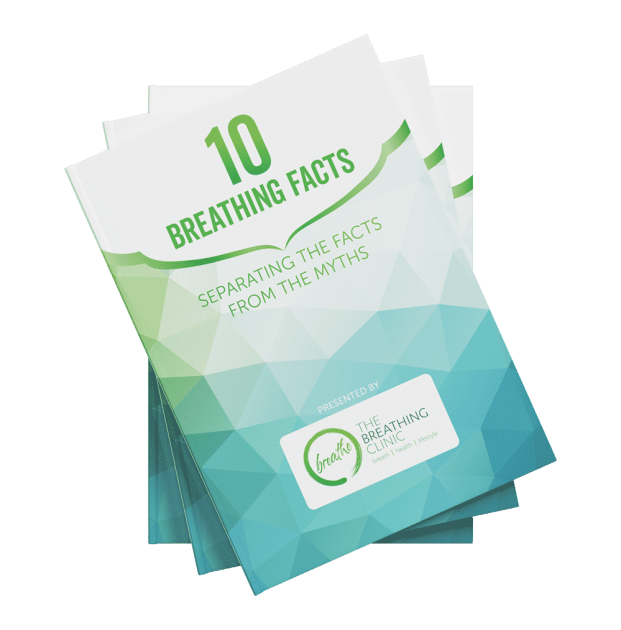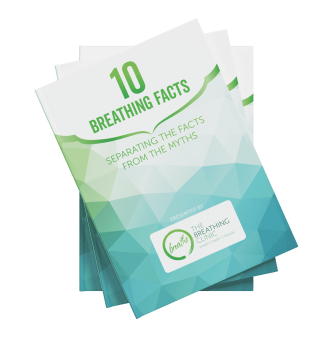Humans are nose breathers
The nose is for breathing and the mouth is for eating. We say to the kids you should breathe through your mouth as often as you eat through your nose! The part of your nose that you can see on your face is only 30% of your nose. 70% is in your head and this is valuable real estate – nature doesn’t waste space. Healthy humans are nose breathers and mouth breathers miss out on at least 29 benefits of nose breathing (see below) and will, in time, suffer numerous detrimental effects from this. Understanding the numerous benefits of nose breathing can significantly impact your overall health and well-being.
Some people who mouth breathe do so from lack of awareness, however for others they are unable to for some reason. If this is the case for you then I would encourage you to book a breathing assessment to learn more and see what can be done to improve your most basic function, your breathing, and therefore your health.
29 Benefits of Nose Breathing
- Gentle nasal breathing reduces congestion and swelling of nasal tissue and airways helping keep the nasal passages open, thereby facilitating nasal breathing and enabling all the benefits included in this list.
- Warms incoming air to body temperature which is optimal for the lungs.
- Humidifies incoming air, providing the lungs with around one litre of moisture per day.
- Regulates and slows the air stream, maximizing exposure to the nasal mucosa and cilia (tiny hairs) lining the airway which provide a protective barrier against viruses, bacteria, fungi, allergens and chemical pollutants.
- Stimulates optimal secretion of healthy mucus, keeping the airways moist, preventing the need to cough and throat clear.
- Lessens the chance of sinus stagnation and infection by keeping the sinus membranes lubricated and functioning well.
- Facilitates the production and inhalation into the lungs of nitric oxide, an essential bronchodilator, vasodilator and potent anti-viral, anti-bacterial and anti-fungal gas.
- Enhances the immune system by triggering the release of antibodies that recognize and bind to bacteria or viruses in incoming air.
- Provides resistance to the flow of air, resulting in 10-20% more oxygen uptake, helping to maintain elasticity of the lungs and ultimately the effectiveness of the heart.
- Regulates breathing and reduces hyperventilation, minimizing excessive loss of carbon dioxide (CO2)during exhalation. CO2 dilates airways and blood vessels and facilitates the release of oxygen from red blood cells (the Bohr Effect).
- Optimizes the biomechanics of breathing, facilitating correct action of the diaphragm which plays many vital health supporting roles in the body.
- Heightens the sense of smell, linking it to the limbic system, the seat of the emotional body, enabling more informed choices in response to the immediate environment.
- Maintains hearing by cleaning the environment around the inner auditory tube at the back of the upper throat, keeping it free from stagnating debris.
- Helps regulate body temperature by bringing air into the sphenoid sinuses and cooling the pituitary gland.
- Enhances sleep by reducing CO2 emissions, helping to maintain balance in the nervous and cardiovascular systems.
- Activates turning of the head and body from side-to-side during sleep, possibly reducing backache, numbness, cramp, and impaired circulation and promoting optimal rest.
- Facilitates healthy movement of several head and neck joints and sutures of the facial and head bones, nourishing the central nervous system and helping to relax the neck and shoulders.
- Contributes to balance by channelling air past the structures that mark the centre of the head.
- Contributes to balance, posture and vagal tone by enabling a closed mouth posture with the tongue on the roof of the mouth.
- Provides a clear passageway for drainage of excess tears.
- Reduces the likelihood of snoring and sleep apnea.
- Enables a closed mouth posture which promotes a healthy oral biome, protecting against increased acidity and drying of the mouth, and reducing the risk of cavities and gum disease.
- Facilitates normal orofacial development by enabling a closed mouth posture with tongue on the roof of the mouth, improving both function and aesthetics of the face and jaw.
- Stimulates optimal sinus formation in childhood.
- Optimizes gas exchange by bringing air into the lower lobes of the lungs where most of the blood supply is.
- Regulates the nervous system and slows the heart rate as the lower lobes of the lungs are connected to the parasympathetic (rest/digest) branch of the autonomic nervous system. Mouth breathing tends to inflate mostly the upper lobes of the lungs, which are connected to sympathetic (fight/flight) nerve fibres.
- Reduces anxiety and promotes a calming effect by regulating the speed of respiration and facilitating optimal inflation of the lungs.
- More effectively engages the diaphragm and reduces over-use of the secondary respiratory muscles in the upper chest, shoulders and neck which in turn engage the sympathetic branch of the autonomic nervous system.
- Deepens the connection to body and self, helping bring attention to the present moment, and promoting an innate sense of well-being.
As you can see, the benefits of nose breathing are numerous and far-reaching. From improved oxygen uptake to better sleep and even facial development, nasal breathing plays a crucial role in our overall health.
By understanding and harnessing the benefits of nose breathing, we can take a simple yet powerful step towards improving our health and quality of life.
“Remember: always try to breathe through your nostrils, and not through your mouth, because air must contact olfactory nerves to stimulate your brain and put it into its natural rhythm. If you don’t breathe through your nose, in a sense you’re only half alive.”
Robert C. Fulford, D.O.
Check your breathing health
Our breathing habits are a major key to health, immunity and good energy levels. There’s a simple test you can do to find out if dysfunctional breathing could be undermining your health.
A simple test to check your breathing health
Author
Nicky McLeod, BA, MBIBH, Breathing Educator and Director of The Breathing Clinic, Nelson
Nicky McLeod — Breathing Clinic Nelson
(Adapted from an original list by Robert Litman)


